Why more earthquakes in some months?
SUNDAY MAY 17, 2015
The Apsidal Changeover
We seem to have had a spate of global earthquakes in the last 4 or 5 days. As always, there has to be a sound reason. Nature is not some random process. I suggest that there is a simple explanation, as usual being the Moon, and because of an unusual feature of one of its main cycles.
There are different kinds of months, depending on what positions are taken as reference points. The phase of 29.5 days is the one we all see, going from full to new moon and back again, and the one our calendars are set to. Then there is the declination cycle in which the moon crosses from northern hemisphere to southern latitudes and back again, a 27.3-day month. But perhaps the most important, when it comes to what causes extreme events on earth, like earthquakes, is a third cycle, independent of the other two, in which during a 27.5 day cycle the moon drifts closer to earth and back out again to space.
Perigee is the day in the month when the moon is closest to earth. Apogee comes half a month later when the moon is furthest away. The cycle from perigee to perigee is called the anomalistic month, and the imaginary line connecting the moon and earth’s centres is called the apsidal line – Latin for arch or orbit). The closest the moon has been to Earth in recent times was on 4 January 1912. It was also full moon. The resulting distance of 356,375kms was the closest the moon had come for 1400 years. As all perigees bring extremes it is possible that this was a factor in the Titanic disaster a few months later. On 20 November 583AD, a new moon day, at 406,722kms the moon was the furthest away apogee yet recorded.
The moon has a more rapid orbiting movement around earth when at or near perigee and a lesser orbital speed around apogee. But the time-split in terms of hours and days from apogee-to-perigee compared to perigee-to-apogee is seldom even. In fact there is an ever-alternating change in the difference in time between the two extreme positions. Each half orbital stage varies between 11 and 16 days, or 280 hours to 380 hours, such that the perigee-to-apogee section on the orbit may be say, 380 hours in one month reducing to 280 hours in about three or four months.
There is a pause or stasis between when the 280 hours has been reached for perigee-to-apogee, and the increase of 380 hours of the apogee-to-perigee section; a changeover period akin to a changing of the guard. Then both remain more or less constant for another month before the hours increase again in the first section of the orbit and with the hours then reducing in the other section.
We already know that earthquakes are more common around perigees, because perigees bring king-tides, not only in water but also land and air. Due to a daily land tide the ground daily rises and falls again by about 55cms at the equator and around 20cms in NZ, with more height variation during the king land tide days. And in any week containing any perigee there is twice the probability of increased seismic activity around the globe.
As an earthquake is release of internal pressure beneath earth’s crust, how the perigee-to-apogee and apogee-to-perigee interval varies suggests changes in available build-up time that may make the difference between just a high land tide on a normal day and what becomes an earthquake event. It is then relevant to look a bit more closely at these apsidal differences.
The orbital speed of the moon in the shorter 280 hours will be declining at a faster rate between perigee and apogee, and increasing at a slower rate from apogee to perigee because the hours in this section will then be near 380. The reverse occurs when the hours are 380 between perigee and apogee and the decline in the moon’s orbital speed will be slower, but the increase in speed between apogee and perigee at 280 hours will be much quicker.
Apogee advances steadily through its total 8.85-year cycle (before returning again to the exact same point) by an average of about 3deg per month, but the position of perigee is monitored by the varying position of new and full moons. As the new or full moons approach the perigee, perigee rebounds back along the orbit path by a few degrees. This action reduces the hours between apogee and perigee to the 280 hours. The perigee will again advance along its monthly orbit until the 380 hours have been achieved, when the new or full moon will again overtake the perigee on the orbital path.
The altering orbital speeds can be related to the declination changes in which at the same time the moon is swapping hemispheres. The amount of time taken for the moon to move from a southern hemisphere position to a northern one and back again, in 27.3 days, will relate to those changing orbital speeds. It follows that if the moon does disturb what is beneath the earth, it must do so at a constantly changing rate.
An increasing orbital speed in the short 280 hour phase if it is apogee to perigee can speed up atmospheric movement, or a slower build-up of orbital speed when apogee to perigee is at 380 hours may hinder atmospheric change. When the 380 alternates with 280, at the point of crossing over, there seems to be a decelerating stress on the moon’s motion, rather like brakes being applied to a speeding car, such that acquired momentum of orbital speed could reasonably be applied elsewhere – so could it be to the geomagnetic field around the earth? If so then it is an earthquake candidate, at the point on earth beneath the lunar changeover.
As the moon moves further away (P to A) its angular momentum decreases and it increases its potential energy. At apogee the moon has its least kinetic energy and maximum potential energy. Although its kinetic energy decreases, its potential energy increases by a larger amount.
The apsidal axis is important in oceanic tides. When the full/new moon is at apogee, the amplitude of tides in New YorkHarbour is 50% lower than when the full/new moon is at perigee. Oceanic tides ride up and down on land tides. Therefore apogee can be expected to play a key role in any moon-sun seismic effect. As the moon decelerates from perigee it collects potential energy from the earth and at apogee the situation is not unlike being armed with a long lever from space.
When looking for earthquake causes we are in the habit of turning to the Christchurch 2010-11 series now, because they are still in our vivid collective memory and also have been so well documented. In the below table are the days between apogee and perigee for the period July 2010 to June 2011. Along the “y” axis are number of hours since the last previous perigee (P) or apogee (A). The graph shows P’s are higher than A’s, for reasons of longer build-up time. The higher values will correspond to around the 380 hours and the lower lines to 280 hours.
It can be seen that the “changeover” periods (boxed) occurred between
14 August (‘inferior’ P) – 7 September (‘superior’ P)
1 December 2010(superior P) – 26 December 2010 (inferior P).
19 Feb 2011(inferior P) – 20 March 2011 (superior P),
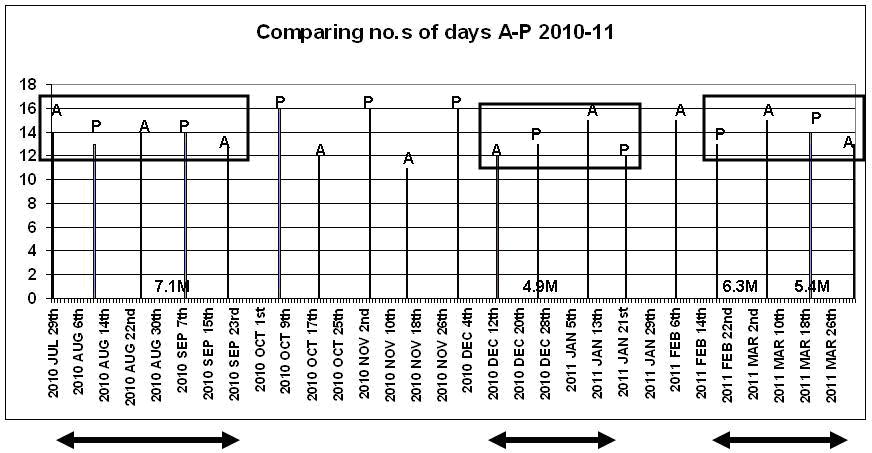
These boxed intervals also happened to be the periods that contained some of the greatest seismic events in Christchurch. The 7.1M occurred in the first bracket on 4 September 2010 and was the largest ever recorded for Christchurch region. Then in the same time frame came the 4.9M on 26 December 2010 in the second bracket, and the 6.3M on 22 February 2011 and, in the last changeover zone, the 5.4M on 20 March 2011. The Japanese tsunami earthquake also occurred on 11 March
The second biggest ever recorded earthquake for Christchurch was a 7.01mag on 9 March 1929. We also find it happened within a changeover range.
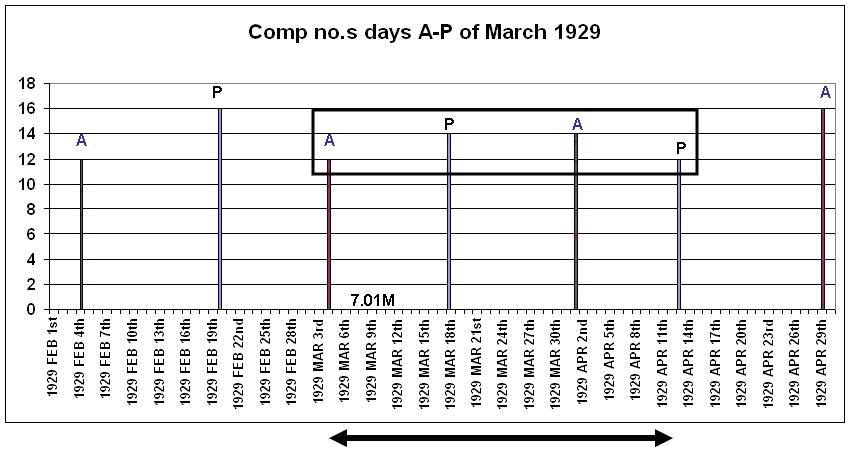
The month of June 1994 saw the start of a large cluster of shakes for Canterbury, mostly in ArthursPass 80kms from the CBD. The 6.7mag was the thirdlargest earthquake ever recorded in Canterbury. The closest perigee that year was 26 April, which appeared in the changeover zone. One would expect earthquakes around then. There was indeed a 5.4mag on 17 April in the NE of the NorthIsland, 6 above-4’s until the 22nd and another 5.4mag on 23rd. On the perigee of the 26th a 4.8mag shook the Bay of Plenty. Then May’s perigee brought a 4.7mag So the changeover period appears to have become seismically active, and to shift activity southwards. But the main cluster of earthquakes accompanied the June perigee, almost right on the solstice. It is as if energy build-up was swamped in the greater tension building towards solstice, before finding its release.
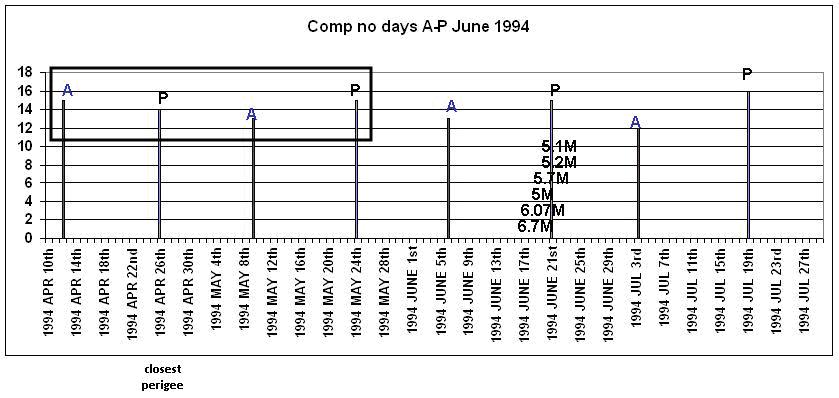
The fourth largest earthquake in Christchurch was on 25 December 1922, which was again in an A to P changeover zone:
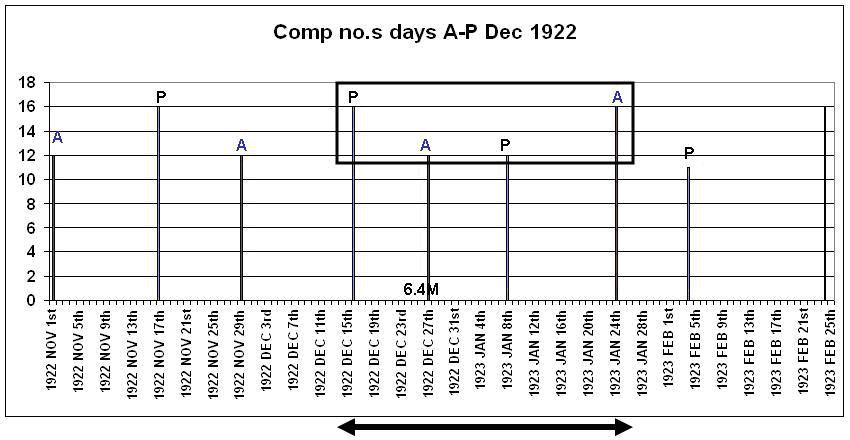
Shifting attention to 2015 we find that in the changeover period between 15 Feb 2015 (inferior perigee) to 15 March 2015 (superior perigee), there was a 5mag on 26 Feb 2015, 105kms north of WhiteIsland, and with the next changeover bracket, 12 June (superior perigee) -9 July (inferior perigee) still to come. But before that there is a large build-up time between apogee of 29 April, to the perigee of 15 May. This indicates a potential earthquake–rich period around 15 May. After this dominating perigee we enter an apsidal changeover between 18 May to 13 July. It is reasonable to expect more earthquakes in this period.
Alternatively if there is a perigee displaying a greater build-up interval before a changeover zone, an impending earthquake may come prematurely or an increase in cluster, and may have diminished tension available for release during the changeover. That may be the current situation following perigee of 15 May. An earthquake is primarily a release of pressure and only secondly a reconfiguring of a landscape.
The last changeover bracket this year will be 28 Sept (inferior perigee) – 28 Oct (superior perigee) which will also contain the closest perigee for the year. Closest perigee is enough in itself to cause a large earthquake. The apogee of 8 November to the perigee of 24 November is also a good build-up period and may therefore bring further increase in seismic activity around 22 November.
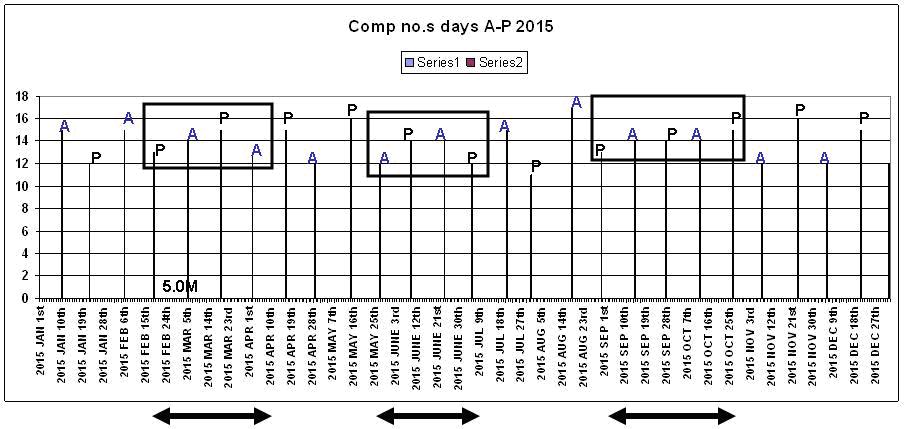
The 6.3mag shake on 13 June 2011 although being just prior to the changeover period, was at the end of a large build-up period between the May apogee and June perigee. This time for build-up to 13 June was greater than for either of the perigees on either side.
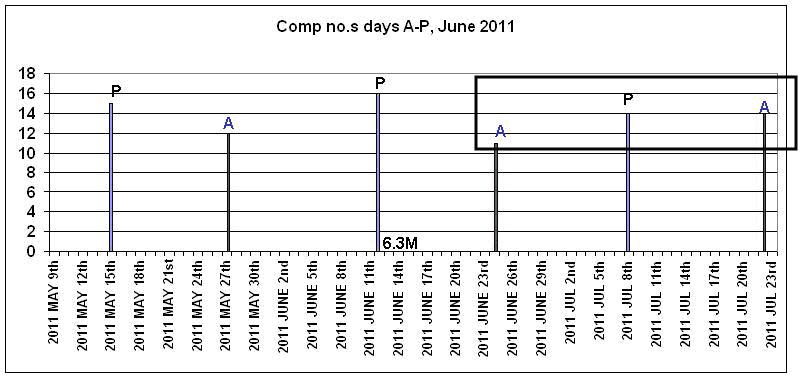
But when it comes to the Napier earthquake of 1931 we cannot ignore that the closest perigee for that year was on 4 March and it is as if the earthquake of 3 February sandwiched itself equally between the changeover zone and the closest moon-earth distance for that year.
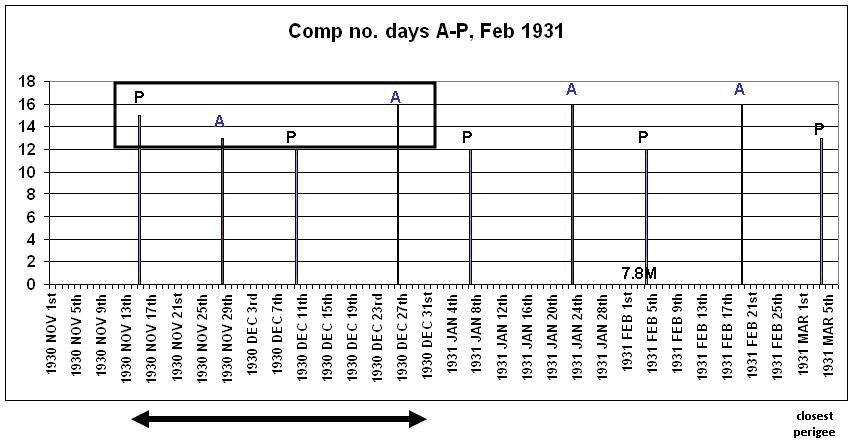
That may have been a pre-warning of impending activity to come, with a 5.5mag in central NZ on 9 November 1930, the first of that size in NZ for 9 months. We might also take note that there was significant P-A wind-down, between 8-24 January, followed by the short wind-up to the perigeal disaster of 3 February.
A very significant cause of more earthquake activity is the closeness of the moon, or perigee, averaged over years. 2015 is the next closest-perigee year, after 2011. The reader may remember the dates of the Christchurch largest earthquakes in 2011. These dates were all within a few days of a perigee.
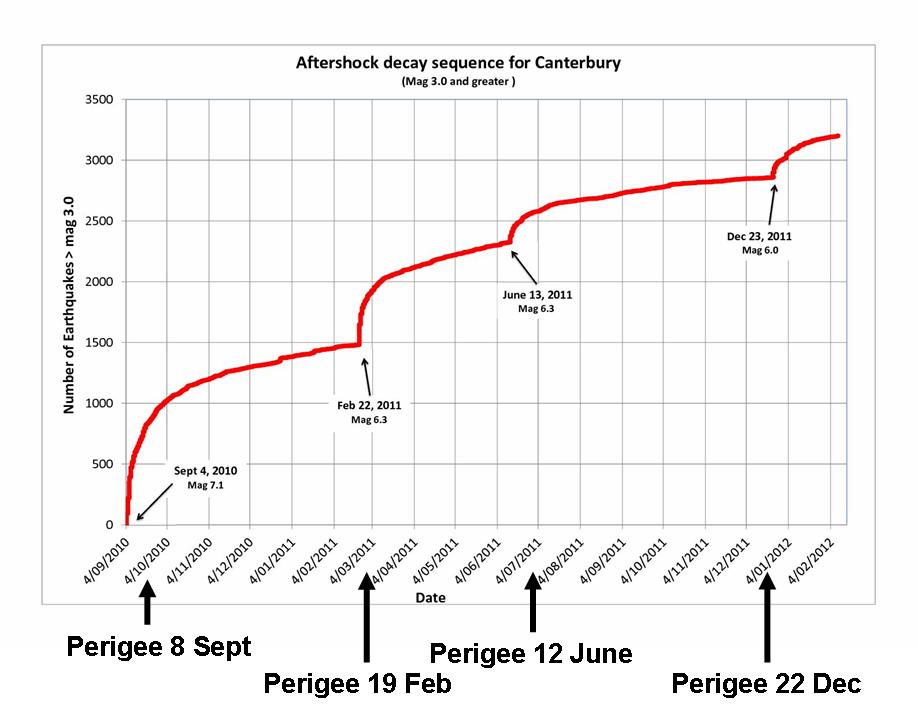
And when we look at whole years themselves, when perigee distance is compared with other years, 2015 stands out as a close-perigee year, on a par with 1997. 2011 was the last previous close-perigee year, and on a par with the early 1900s, when Canterbury was rocked with thousands of earthquakes in the Arthurs Pass district.
.
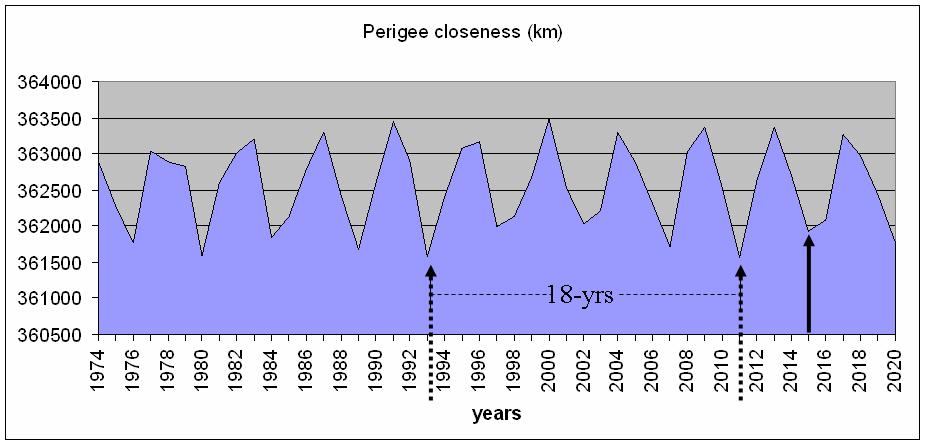
That 2015 is the next close-perigee year could explain a higher number of earthquakes globally. What affects the globe would also affect NZ.
To conclude, whether or not these factors are conducive to larger ground shakes is not known for certain, as the samples may be considered too small and sceptics will always gleefully jump on exceptions to rules.
But in the examples given, it may be said that there are interesting correlations. Just because it is not yet part of western seismology does not make it invalid. Conversely, what if it did turn out to be valid? The progress of science is only possible through investigations of recurring observations. Perhaps one day mainstream geologists with technology and staff at their disposal may wish to investigate these functions.
Ken Ring
May 2015